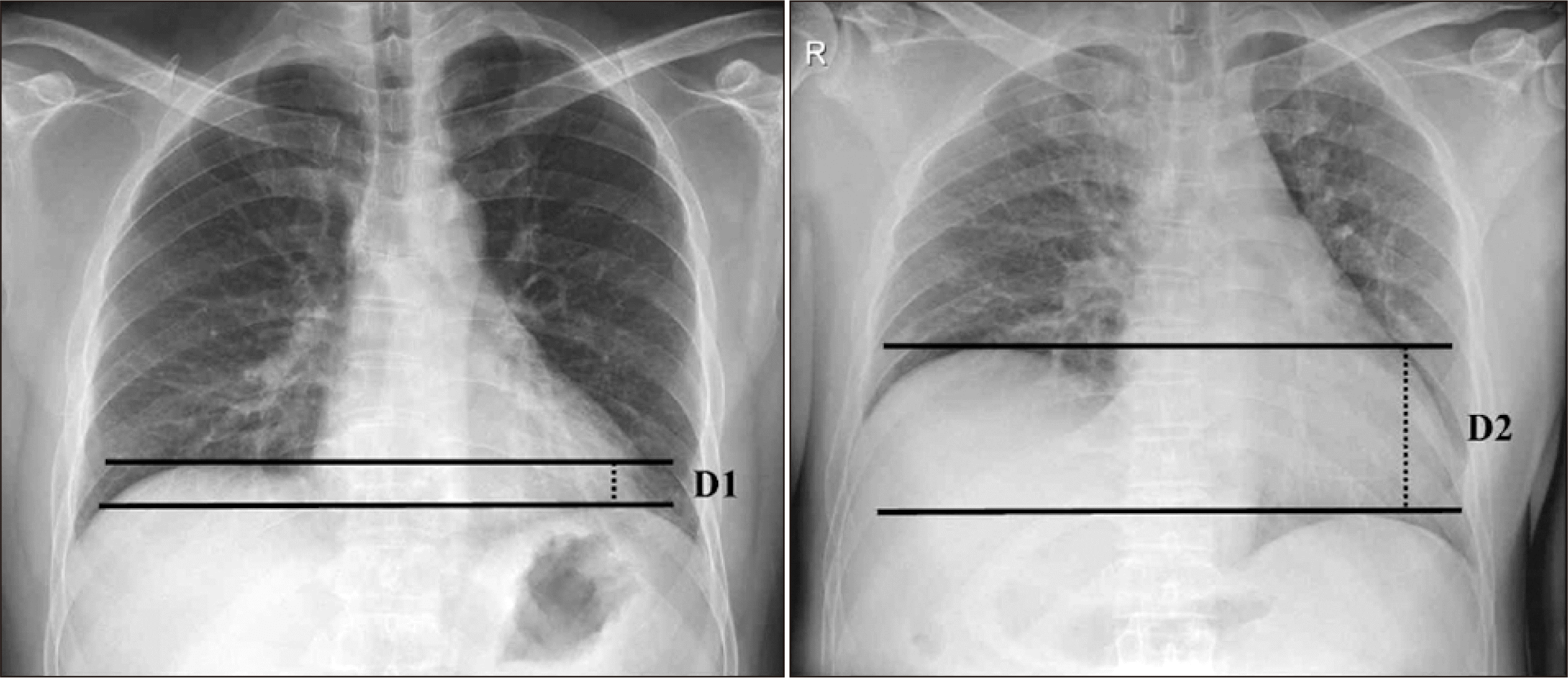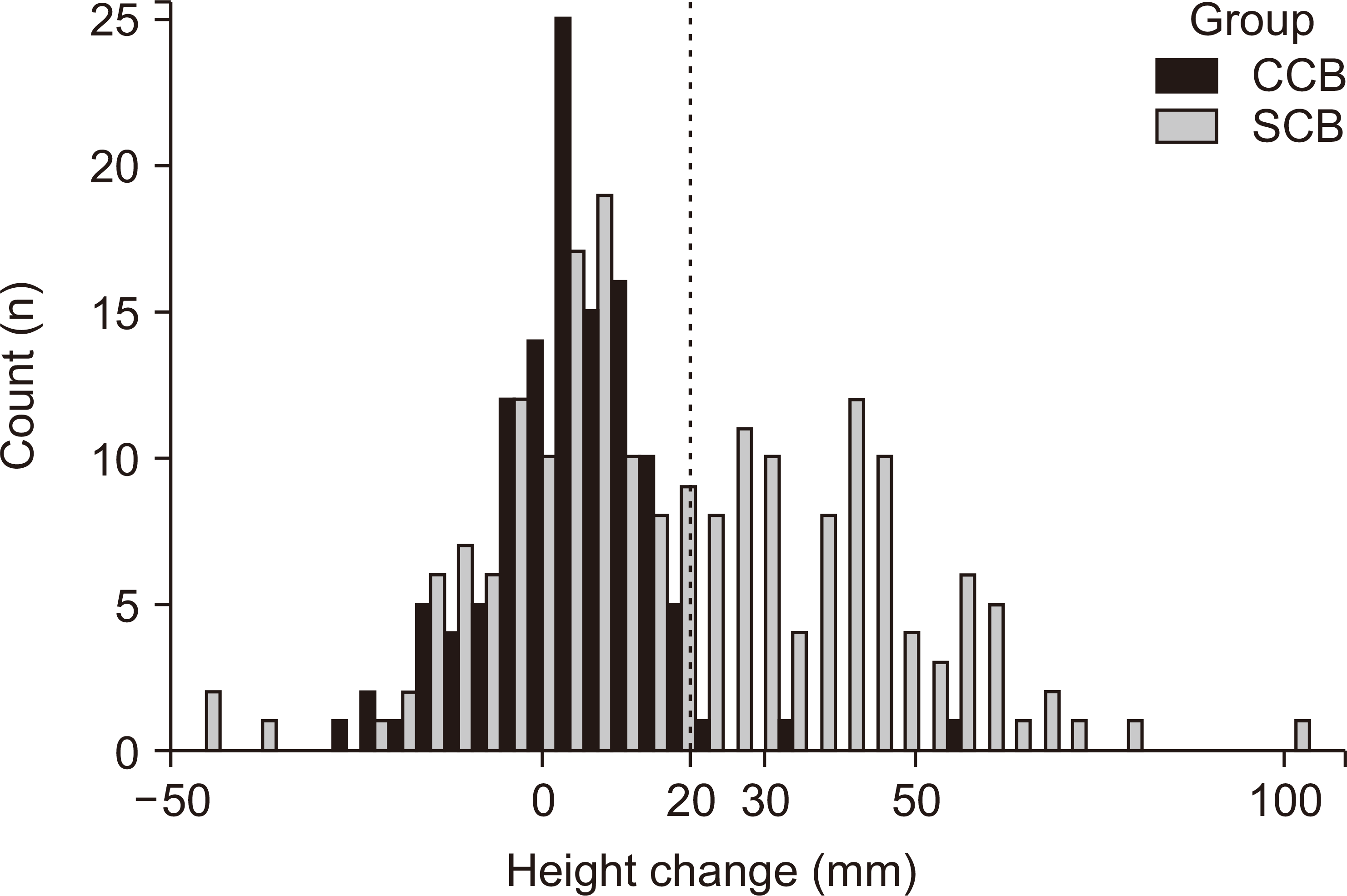1. Kang RA, Chung YH, Ko JS, Yang MK, Choi DH. 2018; Reduced hemidiaphragmatic paresis with a “corner pocket” technique for supraclavicular brachial plexus block: single-center, observer-blinded, randomized controlled trial. Reg Anesth Pain Med. 43:720–4. DOI:
10.1097/AAP.0000000000000795. PMID:
29746446.
2. Mak PH, Irwin MG, Ooi CG, Chow BF. 2001; Incidence of diaphragmatic paralysis following supraclavicular brachial plexus block and its effect on pulmonary function. Anaesthesia. 56:352–6. DOI:
10.1046/j.1365-2044.2001.01708-2.x. PMID:
11284823.

3. Riazi S, Carmichael N, Awad I, Holtby RM, McCartney CJ. 2008; Effect of local anaesthetic volume (20 vs 5 ml) on the efficacy and respiratory consequences of ultrasound-guided interscalene brachial plexus block. Br J Anaesth. 101:549–56. DOI:
10.1093/bja/aen229. PMID:
18682410.

4. Sinha SK, Abrams JH, Barnett JT, Muller JG, Lahiri B, Bernstein BA, et al. 2011; Decreasing the local anesthetic volume from 20 to 10 mL for ultrasound-guided interscalene block at the cricoid level does not reduce the incidence of hemidiaphragmatic paresis. Reg Anesth Pain Med. 36:17–20. DOI:
10.1097/AAP.0b013e3182030648. PMID:
21751435.

5. Stundner O, Meissnitzer M, Brummett CM, Moser S, Forstner R, Koköfer A, et al. 2016; Comparison of tissue distribution, phrenic nerve involvement, and epidural spread in standard- vs low-volume ultrasound-guided interscalene plexus block using contrast magnetic resonance imaging: a randomized, controlled trial. Br J Anaesth. 116:405–12. DOI:
10.1093/bja/aev550. PMID:
26865133.
6. Lee JH, Cho SH, Kim SH, Chae WS, Jin HC, Lee JS, et al. 2011; Ropivacaine for ultrasound-guided interscalene block: 5 mL provides similar analgesia but less phrenic nerve paralysis than 10 mL. Can J Anaesth. 58:1001–6. DOI:
10.1007/s12630-011-9568-5. PMID:
21858614.
7. Ryu TH, Jeon YH, Lim DG. 2004; Postoperative analgesia in dyspneic patient after interscalene brachial plexus block with general anesthesia: a case report. J Korean Pain Soc. 17:266–70. DOI:
10.3344/jkps.2004.17.2.266.

8. Renes SH, Spoormans HH, Gielen MJ, Rettig HC, van Geffen GJ. 2009; Hemidiaphragmatic paresis can be avoided in ultrasound-guided supraclavicular brachial plexus block. Reg Anesth Pain Med. 34:595–9. DOI:
10.1097/AAP.0b013e3181bfbd83. PMID:
19916254.

9. Urmey WF, McDonald M. 1992; Hemidiaphragmatic paresis during interscalene brachial plexus block: effects on pulmonary function and chest wall mechanics. Anesth Analg. 74:352–7. DOI:
10.1213/00000539-199203000-00006. PMID:
1539813.
10. Sotthisopha T, Elgueta MF, Samerchua A, Leurcharusmee P, Tiyaprasertkul W, Gordon A, et al. 2017; Minimum effective volume of lidocaine for ultrasound-guided costoclavicular block. Reg Anesth Pain Med. 42:571–4. DOI:
10.1097/AAP.0000000000000629. PMID:
28723837.

12. Erickson JM, Louis DS, Naughton NN. 2009; Symptomatic phrenic nerve palsy after supraclavicular block in an obese man. Orthopedics. 32:368. DOI:
10.3928/01477447-20090501-02. PMID:
19472948.

13. Gentili ME, Deleuze A, Estèbe JP, Lebourg M, Ecoffey C. 2002; Severe respiratory failure after infraclavicular block with 0.75% ropivacaine: a case report. J Clin Anesth. 14:459–61. DOI:
10.1016/S0952-8180(02)00387-2. PMID:
12393118.
14. Petrar SD, Seltenrich ME, Head SJ, Schwarz SK. 2015; Hemidiaphragmatic paralysis following ultrasound-guided supraclavicular versus infraclavicular brachial plexus blockade: a randomized clinical trial. Reg Anesth Pain Med. 40:133–8. DOI:
10.1097/AAP.0000000000000215. PMID:
25650633.
15. Dullenkopf A, Blumenthal S, Theodorou P, Roos J, Perschak H, Borgeat A. 2004; Diaphragmatic excursion and respiratory function after the modified Raj technique of the infraclavicular plexus block. Reg Anesth Pain Med. 29:110–4. DOI:
10.1097/00115550-200403000-00008. PMID:
15029545.

16. Rodríguez J, Bárcena M, Alvarez J. 2003; Restricted infraclavicular distribution of the local anesthetic solution after infraclavicular brachial plexus block. Reg Anesth Pain Med. 28:33–6. DOI:
10.1097/00115550-200301000-00007. PMID:
12567341.

17. Kessler J, Schafhalter-Zoppoth I, Gray AT. 2008; An ultrasound study of the phrenic nerve in the posterior cervical triangle: implications for the interscalene brachial plexus block. Reg Anesth Pain Med. 33:545–50. DOI:
10.1097/00115550-200811000-00006. PMID:
19258969.

18. Songthamwat B, Karmakar MK, Li JW, Samy W, Mok LYH. 2018; Ultrasound-guided infraclavicular brachial plexus block: prospective randomized comparison of the lateral sagittal and costoclavicular approach. Reg Anesth Pain Med. 43:825–31. DOI:
10.1097/AAP.0000000000000822. PMID:
29923950.
19. Li JW, Songthamwat B, Samy W, Sala-Blanch X, Karmakar MK. 2017; Ultrasound-guided costoclavicular brachial plexus block: sonoanatomy, technique, and block dynamics. Reg Anesth Pain Med. 42:233–40. DOI:
10.1097/AAP.0000000000000566. PMID:
28157792.
20. Karmakar MK, Sala-Blanch X, Songthamwat B, Tsui BC. 2015; Benefits of the costoclavicular space for ultrasound-guided infraclavicular brachial plexus block: description of a costoclavicular approach. Reg Anesth Pain Med. 40:287–8. DOI:
10.1097/AAP.0000000000000232. PMID:
25899958.
21. Sala-Blanch X, Reina MA, Pangthipampai P, Karmakar MK. 2016; Anatomic basis for brachial plexus block at the costoclavicular space: a cadaver anatomic study. Reg Anesth Pain Med. 41:387–91. DOI:
10.1097/AAP.0000000000000393. PMID:
27035461.
22. Aliste J, Bravo D, Layera S, Fernández D, Jara Á, Maccioni C, et al. 2019; Randomized comparison between interscalene and costoclavicular blocks for arthroscopic shoulder surgery. Reg Anesth Pain Med. doi: 10.1136/rapm-2018-100055. DOI:
10.1136/rapm-2018-100055. PMID:
30635497.

23. García-Vitoria C, Vizuete J, López Navarro AM, Bosch M. 2017; Costoclavicular space: a reliable gate for continuous regional anesthesia catheter insertion. Anesthesiology. 127:712. DOI:
10.1097/ALN.0000000000001724. PMID:
28574854.
24. Nieuwveld D, Mojica V, Herrera AE, Pomés J, Prats A, Sala-Blanch X. 2017; Medial approach of ultrasound-guided costoclavicular plexus block and its effects on regional perfussion. Rev Esp Anestesiol Reanim. 64:198–205. DOI:
10.1016/j.redar.2016.09.010. PMID:
27938934.

25. Soares LG, Brull R, Lai J, Chan VW. 2007; Eight ball, corner pocket: the optimal needle position for ultrasound-guided supraclavicular block. Reg Anesth Pain Med. 32:94–5. DOI:
10.1097/00115550-200701000-00019. PMID:
17196502.

26. Lee DK. 2016; An introduction to propensity score matching methods. Anesth Pain Med. 11:130–48. DOI:
10.17085/apm.2016.11.2.130.

27. Ho D, Imai K, King G, Stuart EA. 2011; MatchIt: nonparametric preprocessing for parametric causal inference. J Stat Softw. 42:28. DOI:
10.18637/jss.v042.i08.

28. Albrecht E, Bathory I, Fournier N, Jacot-Guillarmod A, Farron A, Brull R. 2017; Reduced hemidiaphragmatic paresis with extrafascial compared with conventional intrafascial tip placement for continuous interscalene brachial plexus block: a randomized, controlled, double-blind trial. Br J Anaesth. 118:586–92. DOI:
10.1093/bja/aex050. PMID:
28403412.

29. Tran DQ, Elgueta MF, Aliste J, Finlayson RJ. 2017; Diaphragm-sparing nerve blocks for shoulder surgery. Reg Anesth Pain Med. 42:32–8. DOI:
10.1097/AAP.0000000000000529. PMID:
27941477.

30. Leurcharusmee P, Elgueta MF, Tiyaprasertkul W, Sotthisopha T, Samerchua A, Gordon A, et al. 2017; A randomized comparison between costoclavicular and paracoracoid ultrasound-guided infraclavicular block for upper limb surgery. Can J Anaesth. 64:617–25. DOI:
10.1007/s12630-017-0842-z. PMID:
28205117.

31. El-Boghdadly K, Chin KJ, Chan VWS. 2017; Phrenic nerve palsy and regional anesthesia for shoulder surgery: anatomical, physiologic, and clinical considerations. Anesthesiology. 127:173–91. DOI:
10.1097/ALN.0000000000001668. PMID:
28514241.
32. Aliste J, Bravo D, Fernández D, Layera S, Finlayson RJ, Tran DQ. 2018; A randomized comparison between interscalene and small-volume supraclavicular blocks for arthroscopic shoulder surgery. Reg Anesth Pain Med. 43:590–5. DOI:
10.1097/AAP.0000000000000767. PMID:
29630033.

33. Demondion X, Herbinet P, Boutry N, Fontaine C, Francke JP, Cotten A. 2003; Sonographic mapping of the normal brachial plexus. AJNR Am J Neuroradiol. 24:1303–9. PMID:
12917117.
34. Morimoto M, Popovic J, Kim JT, Kiamzon H, Rosenberg AD. 2007; Case series: septa can influence local anesthetic spread during infraclavicular brachial plexus blocks. Can J Anaesth. 54:1006–10. DOI:
10.1007/BF03016635. PMID:
18056210.

35. Brenner D, Mahon P, Iohom G, Cronin M, O’Flynn C, Shorten G. 2018; Fascial layers influence the spread of injectate during ultrasound-guided infraclavicular brachial plexus block: a cadaver study. Br J Anaesth. 121:876–82. DOI:
10.1016/j.bja.2018.04.043. PMID:
30236249.

36. Monzó E, Hadzic A. 2019; Costoclavicular approach to the brachial plexus block: simple or double injection? Reg Anesth Pain Med. doi: 10.1136/rapm-2019-100852. DOI:
10.1136/rapm-2019-100852. PMID:
31570494.

37. Scott S, Fuld JP, Carter R, McEntegart M, MacFarlane NG. 2006; Diaphragm ultrasonography as an alternative to whole-body plethysmography in pulmonary function testing. J Ultrasound Med. 25:225–32. DOI:
10.7863/jum.2006.25.2.225. PMID:
16439786.

38. Boussuges A, Gole Y, Blanc P. 2009; Diaphragmatic motion studied by m-mode ultrasonography: methods, reproducibility, and normal values. Chest. 135:391–400. DOI:
10.1378/chest.08-1541. PMID:
19017880.

39. Testa A, Soldati G, Giannuzzi R, Berardi S, Portale G, Gentiloni Silveri N. 2011; Ultrasound M-mode assessment of diaphragmatic kinetics by anterior transverse scanning in healthy subjects. Ultrasound Med Biol. 37:44–52. DOI:
10.1016/j.ultrasmedbio.2010.10.004. PMID:
21144957.

40. Wade OL, Gilson JC. 1951; The effect of posture on diaphragmatic movement and vital capacity in normal subjects with a note on spirometry as an aid in determining radiological chest volumes. Thorax. 6:103–26. DOI:
10.1136/thx.6.2.103. PMID:
14846056. PMCID:
PMC1018365.

43. Chetta A, Rehman AK, Moxham J, Carr DH, Polkey MI. 2005; Chest radiography cannot predict diaphragm function. Respir Med. 99:39–44. DOI:
10.1016/j.rmed.2004.04.016. PMID:
15672847.








 PDF
PDF Citation
Citation Print
Print




 XML Download
XML Download